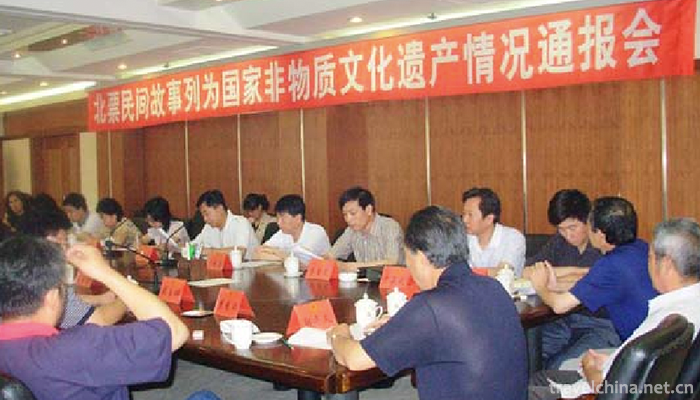Beipiao Folk Stories
Beipiao Folklore is a local folk literature in Liaoning Province. It includes eight categories: folklore, character legend, fantasy story, life story, animal and plant story, custom story, joke, fable and so on. In addition, there are a large number of local folk songs and proverbs.
On June 7, 2008, Beipiao Folk Stories were approved by the State Council to be included in the second batch of national intangible cultural heritage lists.
Historical origin
Beipiao has a history of more than three thousand years.
During the Spring and Autumn Period and the Warring States Period, Beipiao belonged to Donghu Shanrong.
Qin belongs to Liaoxi County.
Western Han Dynasty belongs to Youzhou Liaoxi County.
The Eastern Han Dynasty belongs to Liucheng County, Youzhou County, Liaoxi County.
The Wei and Jin Dynasties belong to Changli County.
The former Yan, the former Qin Dynasty and the latter Yan of the Sixteen Kingdoms of the Eastern Jin Dynasty belong to Changli County.
North Yan belongs to Changli Yinlong City.
The Northern Wei Dynasty belongs to Longcheng (and Longcheng) in Changli County, Yingzhou.
The Eastern Wei Dynasty and the Northern Qi Dynasty belong to Yingzhou.
The Sui Dynasty belongs to Liucheng County, Liucheng County.
Tang belongs to Liaoxi County. In the first year of Tianbao (A.D. 742), Liucheng, the prefecture's governing post, was changed.
Liao belongs to Zhongjing Road, which is located in Beipiao County. In the three years of Huitong (940 A.D.), Xiankang, the prefecture of Sichuan, was established. It has jurisdiction over three counties: Xiankang County (Sijiban, Nanbajiazi Township), Hongli County (Tuchengzi) and Yimin County (Heichengzi Town). Then Shengji County (Shangyuan Town) was set up.
Jin Dading six years (1166) to Chuanzhou Yimin County, belongs to Beijing Road Xingzhong Government.
Yuan belongs to Chuanzhou, Daning Road.
Ming Dynasty belongs to Yingzhou Qianyouweitun (Chaoyang) and later to Tainingwei (Chaoyang to the west of Liaohe River in Fuxin is also called Tummet Right Flag of Zhuosuotu League in Mongolia).
Qing belongs to the eastern border of Tazigou Hall.
Guangxu 30 years (1904) is under the jurisdiction of Chaoyang County.
primary coverage
Folk literature is a linguistic art created orally and handed down orally by the people. Beipiao has a long history and profound cultural accumulation. As an organic part of the spiritual wealth inherited and created by the people of Beipiao, the folk literature of Beipiao naturally reflects the spiritual style of the people of Beipiao from all aspects, and the unique historical and cultural characteristics and distinctive artistry of Beipiao, a hot land. Local folklores and stories handed down from generation to generation are precious folk cultural heritages shared by the Mongolian and Han nationalities in Western Liaoning Province. They have distinct regional cultural characteristics and important scientific, historical and cultural values.
Inheritance significance
Beipiao folk tales have a strong and simple artistic style, inheriting the characteristics of Han folk literature better than narrative, and absorbing the artistic characteristics of Mongolian folk literature better than analogical description. The folk tales in Beipiao are easy and popular in language, smooth and natural in narration, distinctive in characters, rich in the characteristics of Chinese folk literature, exuding a strong local flavor, and of high humanistic value. These folk literary works, or beautiful and moving myths and legends, or thought-provoking folk stories, or lively and simple folk songs, or folk proverbs to alert future generations, are all the crystallization of wisdom of the Beipiao people of all nationalities and are well received by the people.
Inheritance status
In 1984, the Beipiao Municipal Culture Museum published a collection of folk tales, The Songs of Tummett. From 1985 to 1987, in the three integrated projects of folk literature in the major National Humanities Research projects, a 500,000-word "Chinese Folk Literature Integrated Liaoning Volume Beipiao Data Book" was awarded the first prize in the provincial evaluation. In 2008, Beipiao Cultural Bureau published the first volume of Beipiao Folk Literature.

0 Questions
Ask a Question
Your email address will not be published.